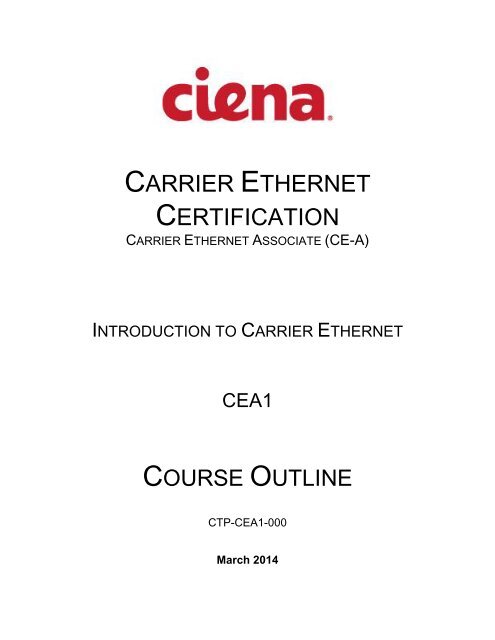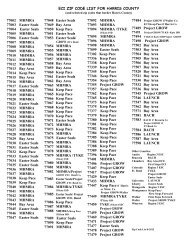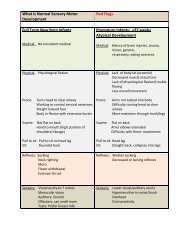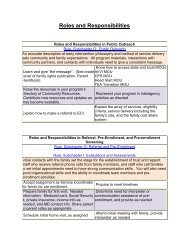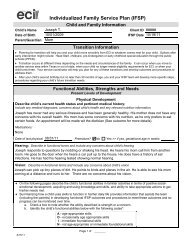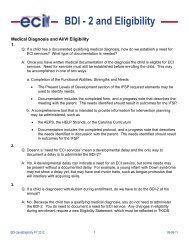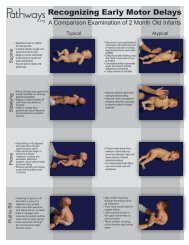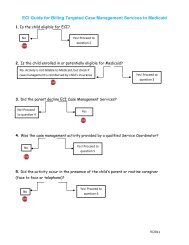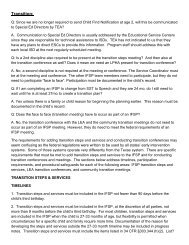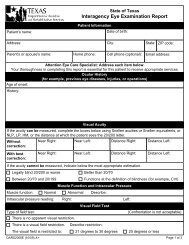CE Certification CE-A Introduction to Carrier Ethernet ... - ABC Signup
CE Certification CE-A Introduction to Carrier Ethernet ... - ABC Signup
CE Certification CE-A Introduction to Carrier Ethernet ... - ABC Signup
You also want an ePaper? Increase the reach of your titles
YUMPU automatically turns print PDFs into web optimized ePapers that Google loves.
CARRIER ETHERNET<strong>CE</strong>RTIFICATIONCARRIER ETHERNET ASSOCIATE (<strong>CE</strong>-A)INTRODUCTION TO CARRIER ETHERNET<strong>CE</strong>A1COURSE OUTLINECTP-<strong>CE</strong>A1-000March 2014
<strong>Certification</strong> – <strong>Carrier</strong> <strong>Ethernet</strong> Associate (<strong>CE</strong>-A)<strong>Introduction</strong> <strong>to</strong> <strong>Carrier</strong> <strong>Ethernet</strong>A. INTRODUCTIONThe <strong>Carrier</strong> <strong>Ethernet</strong> Associate (<strong>CE</strong>-A) <strong>Introduction</strong> <strong>to</strong> <strong>Carrier</strong> <strong>Ethernet</strong> course is a five-daycourse designed for anyone seeking a firm understanding of <strong>Carrier</strong> <strong>Ethernet</strong> (<strong>CE</strong>)standards, terminology, concepts, and applications. In addition, <strong>CE</strong>-Associate certificationprovides the prerequisite knowledge for the next level of certification, <strong>CE</strong>-Professional.B. OBJECTIVESUpon successful completion of this course, students should be able <strong>to</strong>:Identify the basic concepts of <strong>Ethernet</strong> and define <strong>CE</strong>Identify the technology of <strong>CE</strong>List the types of services provided by <strong>CE</strong>Differentiate among the network <strong>to</strong>pologiesIdentify the service <strong>to</strong>pologiesIdentify service attributes and Metro <strong>Ethernet</strong> Forum (MEF) servicesIdentify the standards used for services and network moni<strong>to</strong>ringIdentify the resiliency features of <strong>CE</strong>Describe the role that synchronization plays in a <strong>CE</strong> network and list twosynchronization solutionsExplain trends and emerging technologies associated with next-generationnetworksC. CONDITIONSClass conditions include the following:There is a maximum class size of 12 students.Lectures take place in a classroom using projec<strong>to</strong>r displays.Demonstrations are conducted in the classroom. Class time balance is: (approximately) 95% formal presentation and 5%administrative activities.D. PREREQUISITESRecommended prerequisites include the following:Awareness of digital communications technology and telecommunicationssystemsCopyright© 2014 Ciena Corporation. All rights reserved. March 20141
<strong>Certification</strong> – <strong>Carrier</strong> <strong>Ethernet</strong> Associate (<strong>CE</strong>-A)<strong>Introduction</strong> <strong>to</strong> <strong>Carrier</strong> <strong>Ethernet</strong>E. COMPLETION AND POST-COURSE EXAMINATIONThere is an online, post-course examination associated with this course. The duration ofthe exam is 2 hours, and the exam is administered separately from the training courseStudents taking the <strong>Carrier</strong> <strong>Ethernet</strong> Associate training have two options for completion:The student opts <strong>to</strong> receive a Certificate of Completion and is, therefore, notrequired <strong>to</strong> complete the examination.The student completes the examination with a passing grade and receives a<strong>Carrier</strong> <strong>Ethernet</strong> Associate certificate. (Please note: It is expected that the studentwill complete the post-course examination within 30 days of completing thecourse. If the time period between course completion and post-courseexamination exceeds 30 days, or should the student need <strong>to</strong> re-take theexamination, an additional cost would apply).F. TIMEThe scheduled time for this training course is 5 days.G. COURSE OUTLINEModule 0.<strong>Carrier</strong> <strong>Ethernet</strong> <strong>Certification</strong> Program OverviewThis module provides an overview of the levels of the <strong>CE</strong> <strong>Certification</strong> Program.Module 1.<strong>Ethernet</strong> BasicsThis module covers the fundamental concepts of <strong>Ethernet</strong> technology and datatransmission in <strong>Ethernet</strong> networks.At the end of this module, students will be able <strong>to</strong>:Describe the functional layers of the Open Systems Interconnection (OSI)Reference ModelExplain the development of <strong>Ethernet</strong> standardsDescribe the Physical layer characteristics of <strong>Ethernet</strong>List the types of devices in a <strong>CE</strong> networkDescribe the structure of an <strong>Ethernet</strong> frameExplain how networks can be extended and segmented using various<strong>Ethernet</strong> devicesDescribe how frames are forwarded in an <strong>Ethernet</strong> networkExplain, at a high level, how Virtual Local Area Networks (VLANs) functionCopyright© 2014 Ciena Corporation. All rights reserved. March 20142
<strong>Certification</strong> – <strong>Carrier</strong> <strong>Ethernet</strong> Associate (<strong>CE</strong>-A)<strong>Introduction</strong> <strong>to</strong> <strong>Carrier</strong> <strong>Ethernet</strong>Module 2.<strong>Carrier</strong> <strong>Ethernet</strong> TechnologyThis module describes <strong>CE</strong> technology basics, switching behavior in <strong>CE</strong> networks,and criteria for selecting Network Elements (NEs) for deployment at varioushierarchical levels in a <strong>CE</strong> network.At the end of this module, students will be able <strong>to</strong>:Module 3.Provide a brief definition of <strong>CE</strong>Identify the attributes and features of <strong>CE</strong> as defined by the MEFDescribe key applications supported by <strong>CE</strong>Explain how User Network Interfaces (UNIs), Network-<strong>to</strong>-Network Interfaces(NNIs), and Cus<strong>to</strong>mer Premise Equipment (CPE) are used in the <strong>CE</strong> networkIdentify the functional requirements of the network coreIdentify the functional requirements of the metro edgeIdentify the functional requirements of the cus<strong>to</strong>mer edge<strong>Carrier</strong> <strong>Ethernet</strong> ServicesThis module classifies and describes voice, data, and video services deliveredusing <strong>CE</strong> technology. The module also describes the service attributes that definethe quality of <strong>CE</strong> services.At the end of this module, students will be able <strong>to</strong>:Define a <strong>CE</strong> serviceIdentify key service attributesExplain the difference between access-based and connectivity-basedservicesDescribe <strong>CE</strong> voice servicesDescribe <strong>CE</strong> video servicesDescribe <strong>CE</strong> data servicesCopyright© 2014 Ciena Corporation. All rights reserved. March 20143
<strong>Certification</strong> – <strong>Carrier</strong> <strong>Ethernet</strong> Associate (<strong>CE</strong>-A)<strong>Introduction</strong> <strong>to</strong> <strong>Carrier</strong> <strong>Ethernet</strong>Module 4.Network TopologiesThis module focuses on the definition, identification, and operating characteristicsof three fundamental network <strong>to</strong>pologies used in <strong>CE</strong> networks.At the end of this module, students will be able <strong>to</strong>:Module 5.Describe the types of network <strong>to</strong>pologiesDescribe the features of the star <strong>to</strong>pologyDescribe the features of the ring <strong>to</strong>pologyDescribe the features of the mesh <strong>to</strong>pologyConnectivity-Based ServicesThis module describes the logical <strong>to</strong>pologies used by NEs in <strong>CE</strong> networks. Inaddition, this module discusses <strong>Ethernet</strong> Virtual Connections (EVCs),encapsulation, and different connectivity-based service types as described by theMEF standards for implementing logical <strong>to</strong>pologies.At the end of this module, students will be able <strong>to</strong>:Module 6.Describe logical <strong>to</strong>pologiesDescribe EVCsDescribe the services built on the logical <strong>to</strong>pologiesDefine network encapsulationService AttributesThis module describes the various attributes of a <strong>CE</strong> service and also describesQuality of Service (QoS).At the end of this module, students will be able <strong>to</strong>:Module 7.Define service attributesDescribe the configurable and non-configurable attributes included in <strong>CE</strong>servicesDescribe QoS and the associated parametersServices and Network Moni<strong>to</strong>ringThis module describes various pro<strong>to</strong>cols and standards used for services andnetwork moni<strong>to</strong>ring in <strong>CE</strong> networks.At the end of this module, students will be able <strong>to</strong>:Describe the purpose, methods, and pro<strong>to</strong>cols used for services moni<strong>to</strong>ringDescribe the purpose, methods, and pro<strong>to</strong>cols used for network moni<strong>to</strong>ringCopyright© 2014 Ciena Corporation. All rights reserved. March 20144
<strong>Certification</strong> – <strong>Carrier</strong> <strong>Ethernet</strong> Associate (<strong>CE</strong>-A)<strong>Introduction</strong> <strong>to</strong> <strong>Carrier</strong> <strong>Ethernet</strong>Module 8.<strong>Carrier</strong> <strong>Ethernet</strong> ReliabilityThis module covers a set of pro<strong>to</strong>cols that can be applied in a <strong>CE</strong> network <strong>to</strong>achieve reliable service delivery.At the end of this module, students will be able <strong>to</strong>:Module 9.Define reliabilityDescribe how redundancy and resiliency influence reliabilityDescribe how availability is used <strong>to</strong> measure the stability of a networkDescribe the pro<strong>to</strong>cols used <strong>to</strong> design a reliable networkSynchronization in <strong>Carrier</strong> <strong>Ethernet</strong> NetworksThis module discusses synchronization among <strong>CE</strong> devices and the rolesynchronization plays in delivering <strong>CE</strong> services.At the end of this module, students will be able <strong>to</strong>:Describe the difference between synchronous and asynchronous networksExplain why synchronization pro<strong>to</strong>cols are being developed for asynchronousnetworks like <strong>Ethernet</strong>Understand the purpose and operating fundamentals of Synchronous<strong>Ethernet</strong> (SyncE)Understand the purpose and operating fundamentals of the Precision TimePro<strong>to</strong>col (PTP)Describe use cases for synchronization services, including wireless backhauland Circuit Emulation Services (<strong>CE</strong>S)Copyright© 2014 Ciena Corporation. All rights reserved. March 20145
<strong>Certification</strong> – <strong>Carrier</strong> <strong>Ethernet</strong> Associate (<strong>CE</strong>-A)<strong>Introduction</strong> <strong>to</strong> <strong>Carrier</strong> <strong>Ethernet</strong>Module 10.<strong>Carrier</strong> Network EvolutionThis module explores the changes in consumer and business behaviors and thechanges in technologies that are the drivers behind the shift. Also, the modulecovers the proposed solutions <strong>to</strong> service provider challengesAt the end of this module, students will be able <strong>to</strong>:Discuss the cloud service modelList the types of cloud services and their usesList cloud service applications and their impact on carrier networksIdentify cloud challengesIdentify the solutions for the challenges faced by the service providers,namely, Software-Defined Networking (SDN) and Network FunctionVirtualization (NFV)Identify cloud challenges that can be addressed by <strong>CE</strong>Copyright© 2014 Ciena Corporation. All rights reserved. March 20146


